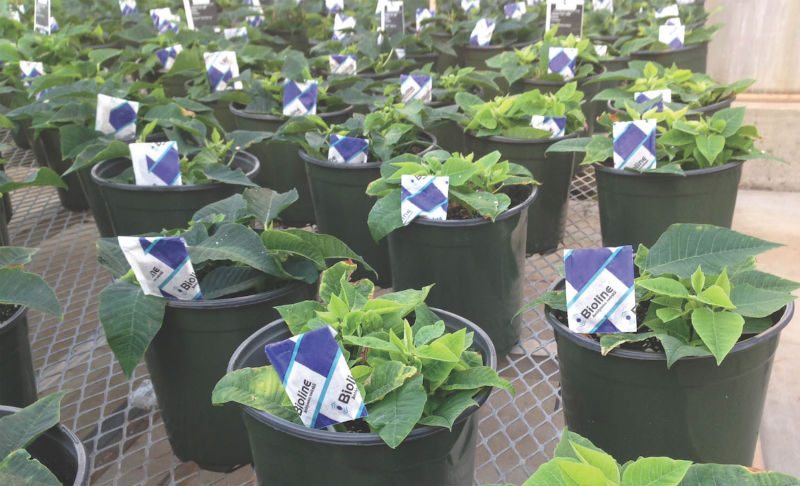
Effective Release Methods of Predatory Mites
The use of predatory mites is an essential part of biocontrol programs used by both vegetable and ornamental growers around the world. One of the first commercially produced biocontrol agents, back in the late 1960s, was Phytoseiulus persimilis, a predatory mite to control two spotted spider mite (TSSM). Since then several other species of predatory mites have been introduced to control a range of different pests: Amblyseius cucumeris, Amblyseius swirskii, Ambyseius californicus and many others.
The thing that all these species have in common — they are predatory mites, not insects. One significant difference between insect and mite biocontrol agents is that mites cannot fly, meaning success with predatory mites depends a lot on choosing the right introduction method.
A Bit of History
In the early days, biocontrol was mainly focused on cucumber and tomato crops in the Netherlands and the United Kingdom. Both crops are susceptible to whitefly, and cucumber crops were also battling with pesticide resistant TTSM. Fifty years ago Phytoseiulus persimilis became a commercially produced biocontrol agent, primarily focused on TTSM control in cucumbers. Phytoseiulus persimilis is highly effective; its high predation rate and fast reproduction allow it to quickly overcome TSSM populations. However, the key to success with this strategy is to start introductions when TSSM populations are still very low.
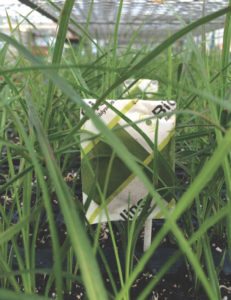
Phytoseiulus persimilis is a specialist predator; it only accepts TSSM as prey, and therefore it has adapted to be very good at searching for its prey. Even though it can’t fly, it is highly mobile and will travel from plant to plant and even over crop support wires to find prey on neighboring plants.
Phytoseiulus persimilis is now used in many countries and in many different crops including greenhouse vegetable and ornamental crops, foliage and potted plant production as well as the soft fruit and strawberry crops in, for example, California.
With increasing international travel in young plant material, Western flower thrips (Frankliniella occidentalis) became a problem in many countries in the 1980s. As a result, Amblyseius cucumeris was introduced for the control of thrips. This predatory mite targets immature thrips, and more specifically larval stage 1. This means the window of opportunity is only about three days at 68° F and one and a half days at 86° F. To be successful, this predator must be present on the plants at all times and ideally in high numbers.
In greenhouse bell peppers, it was fairly easy to get a population of Amblyseius cucumeris established, a few broadcast applications early in the crop cycle were enough to get the job done. In long English cucumbers it was a very different story. What is the difference? Pollen availability. Most Amblyseius species can feed on pollen as a supplementary food and pepper crops have lots of pollen whereas long English cucumber varieties don’t because they only produce female flowers. For cucumber growers to be successful, they had to broadcast Amblyseius cucumeris on a weekly basis. This was labor intensive, costly and tricky because one week of missed introduction could lead to failure.
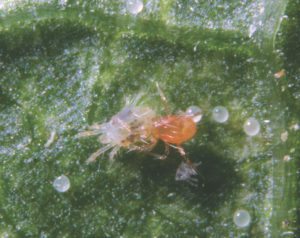
In 1989, a major change was developed that has impacted how many predatory mites are available today. It all started with a single stem flower flask (bottle), in the Netherlands known as ‘Anthurium flesjes.’ One cucumber grower filled some of the flasks with Amblyseius cucumeris and carrier material and placed them in the crop to release predatory mites every day. The results were incredible and many other cucumber growers followed this example, leading to a serious shortage of these little bottles in the spring of 1990 in the Netherlands.
This was the “birth” of CRS sachets (Control Release System) of predatory mites and in 1991 the first commercially available Amblyseius cucumeris CRS sachets became available. Before long, pepper growers also realized the benefits of CRS sachets and started using this technique to introduce predatory mites.
How does it work? Amblyseius cucumeris (and several other Amblyseius species) are produced on bran mite species, hence the bran as a carrier. The typical ratio between predatory mite and bran (feeder) mite is 1:10. The bran is also inoculated with a fungus and other ingredients to keep the bran mite population healthy. These sachets are literally an extension of the production that takes place at the biocontrol producers. These sachets produce predatory mites anywhere from four to eight weeks, depending on the mite species and the conditions that they are used in. The main advantage of using breeding sachets versus broadcasting is not limited to less frequent introductions. It has also been proven repeatedly that the use of breeding sachets gives more consistent and higher levels of predatory mites, which means higher success rates of using biological control.
Modifications for the Ornamental Industry
In the early 2000s, when biocontrol started to become more popular in the ornamental industry, it became clear the CRS system wasn’t suited to ornamental crops. The first development was the gemini sachet (2002), which is two sachets connected together so they can be hung over a mesh crop support wire (like a saddle on a horse) in cut flower production, primarily cut chrysanthemum. As this technique was still labor intensive, the next development was the bugline (2006), later followed by Certirol. This is a long roll of continuous sachets where only every third or sixth sachet is filled with mites; this is rolled out over the mesh crop support wire, saving labor and at the same time creating a ‘mite highway’ for better distribution of mites. Most of these developments were focused on the cut flower industry, but what about spring bedding plants and hanging baskets?
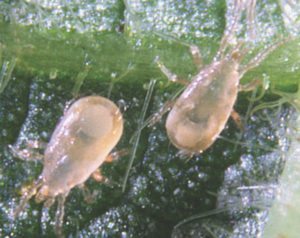
In 2006-2007, when thrips control became much more challenging due to resistance issues, the ornamental industry in North America started to focus on biocontrol in spring ornamentals and hanging baskets. At first, breeder piles were used, which are a bulk version of the sachet mix placed in a small pile on the soil-surface close to the base of the plant. This was OK, but overhead watering and predation by other biological control agents BCAs meant they only produced mites for a few weeks. In 2007, a New York grower started using CRS sachets and he hung one sachet on every four baskets. It didn’t work! In April of that year we saw something interesting … the verbena baskets with the sachet had far less thrips damage than the other three baskets.
It became clear the mites would not move from basket to basket. This led to the development of mini sachets (2009), which have about 25 percent of the mites compared to the traditional CRS sachets, making them cost effective for protecting every single basket with a sachet. Interestingly, greenhouse vegetable growers have also started using mini sachets because they can achieve a better distribution of predatory mites at a very similar cost.
Over time, the concept of release sachets has continued to evolve, with the most recent development starting in Canada in 2014. Several ornamental and vegetable propagators were stapling sachets to plant labels or popsicle sticks to introduce the sachets even earlier in the production process. As previously mentioned, timing of establishing predatory mites is “make or break” for success, so the earlier the better. The biocontrol industry responded by developing the sachet on a stick (2014). As these sachets are used in propagation (and outdoors), where overhead mist or water is a given fact, the sachets are produced with water-resistant paper and the exit hole is protected so water cannot get in. Once again, the uptake of this type of sachet was broader than expected, with many growers choosing to switch to the stick sachet because it is easier to place.
Do I Broadcast/Blow or Stick/Hang Predatory Mites?
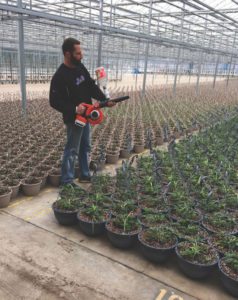
Despite the invention and uptake of sachets, in some situations Amblyseius predatory mites are still applied by broadcasting or using modified leaf blowers. This is mostly done when it is thought that it is not cost effective to use a sachet. For broadcast or blowing application there are formulations of Amblyseius cucumeris that are close to 100 percent vermiculite carrier, which makes the application easier and more consistent than the bran formulation.
If blowing, it is important to monitor the survival of the mites and the quality of the distribution, this can be done using a large white cardboard sheet. Gas powered blowers are known to have low survival rates. Another thing that is critical when broadcasting is weekly applications, as there is very little reproduction happening in the crop. Even consistently missing 5 percent with weekly applications can result in thrips problems two or three generations down the road. Also, when broadcasting or blowing ask yourself the question, how many mites actually end up on the plant?
Once taking losses and labor into account, many growers realize that blowing or broadcasting weekly at 10 mites per square foot often costs the same as using sachets. The key point is that, in general, breeding sachets have shown to result in more consistent and higher numbers of predatory mites, which means higher success rates of biocontrol programs.
Interestingly, despite being one of the first commercially available species, Phytoseiulus persimilis is not available in a sachet because it only accepts TSSM as prey and cannot be produced on bran mites. It can therefore only be applied by either broadcasting or blowing with a modified leaf blower. However, this species may once again be at the cutting edge of biocontrol innovation because testing for drone application of BCAs has so far focussed on this species.
Future and Conclusion
The way that predatory mites are released into crops has significantly changed over the last three decades. The development of breeding sachets, and further modifications of these sachet systems, has positively impacted the results of biocontrol programs around the world. Broadcasting or blowing of mites is still used in some situations, but has limitations compared to breeding sachets. When broadcasting or blowing, it is critical to check survival and distribution of the mites.
The story of mite distribution methods is far from over; applying predatory mites with drone technologies is on the horizon, especially for field-grown crops such as strawberries. Furthermore, supplementary feeding of mites actually on the crop, using pollen or sterile bran mites, is set to become an increasingly important strategy in the future.
All these strategies have a common goal: protecting the crop with a consistently high population of predatory mite in a cost-effective manner.









 Video Library
Video Library 


















